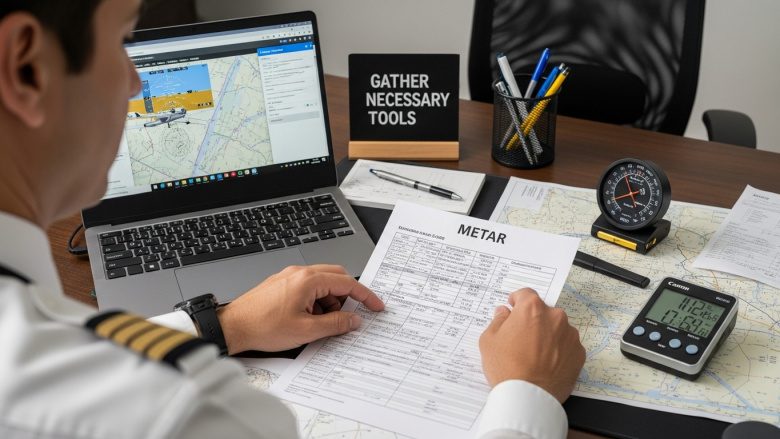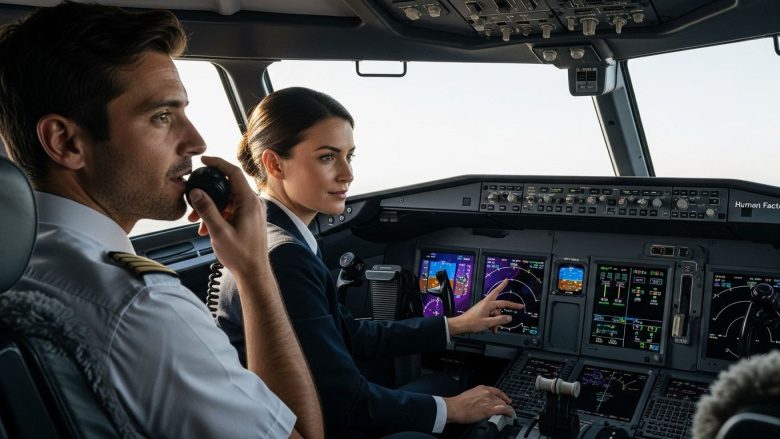Dreaming of piloting a commercial jet or gliding through blue skies solo? Some pilot training programmes require as few as 45 documented flight hours before you can earn your first licence. That seems surprisingly quick for such a high-skill career. But the real challenge is not just clocking those hours, it starts with a maze of national regulations, fierce medical exams and the right school—each step more vital than the last.
Table of Contents
- Step 1: Research The Pilot Requirements In Your Country
- Step 2: Choose The Right Flight School For Your Needs
- Step 3: Obtain A Medical Certificate From An Aviation Medical Examiner
- Step 4: Enrol In Ground School And Complete Theoretical Training
- Step 5: Begin Flight Training With A Certified Instructor
- Step 6: Complete Required Flight Hours And Pass The Checkride
Quick Summary
| Key Point | Explanation |
|---|---|
| 1. Research your country’s pilot requirements | Understand unique regulations, medical standards, and licensing procedures relevant to aspiring pilots in your country. |
| 2. Choose the right flight school | Assess integrated vs. modular training paths, accreditation, instructor qualifications, and cost to find a suitable flight school. |
| 3. Obtain a medical certificate | Complete a comprehensive health examination with an aviation medical examiner to confirm your fitness for flying. |
| 4. Complete theoretical training and ground school | Engage deeply with subjects like aerodynamics, navigation, and regulations to build essential aviation knowledge. |
| 5. Pass the checkride after required flight hours | Accumulate specified flight hours and successfully complete both a written test and practical flight evaluation to become certified. |
Step 1: Research the Pilot Requirements in Your Country
Becoming a pilot starts with understanding the specific requirements in your country. Each nation has unique regulations, medical standards, and licensing procedures that aspiring pilots must navigate carefully. Aviation authorities like the European Union Aviation Safety Agency (EASA) or the Federal Aviation Administration (FAA) establish comprehensive guidelines that determine your path to becoming a professional pilot.
Learn more about pilot certification requirements by first identifying your local aviation regulatory body. This initial research is crucial because requirements can vary significantly between countries. In most regions, you will need to meet several fundamental criteria:
- Minimum age requirement (typically 17-18 years old)
- Secondary education completion
- Basic medical fitness standards
- Language proficiency (especially in English)
Your journey begins with comprehensive research into these national requirements. Contact your country’s civil aviation authority directly to obtain the most accurate and up-to-date information. Many aviation authorities provide detailed online resources, guidance documents, and specific checklists for aspiring pilots.
Medical certification represents a critical component of this initial stage. Professional pilot medical examinations are stringent and assess your physical and mental fitness to operate aircraft. You will need to undergo thorough medical evaluations, which typically include vision tests, hearing assessments, cardiovascular screenings, and neurological examinations.
Beyond medical requirements, investigate the specific pilot licensing levels available in your country. These often include Private Pilot License (PPL), Commercial Pilot License (CPL), and Air Transport Pilot License (ATPL). Each license has distinct training requirements, medical standards, and professional opportunities.
Documentation plays a crucial role in this research phase. Gather all necessary paperwork, including educational certificates, identification documents, and any preliminary medical clearances. Organize these materials systematically to streamline your future application processes.
Consider reaching out to local flight schools, pilot associations, and professional networks. These connections can provide invaluable insights into current requirements, potential challenges, and practical advice for navigating the licensing process. Professional pilots and instructors can offer first-hand perspectives that official documentation might not capture.
Remember, thorough research at this stage saves considerable time and potential setbacks in your pilot training journey. Take your time, be meticulous, and ensure you understand every requirement before proceeding to subsequent steps of pilot certification.
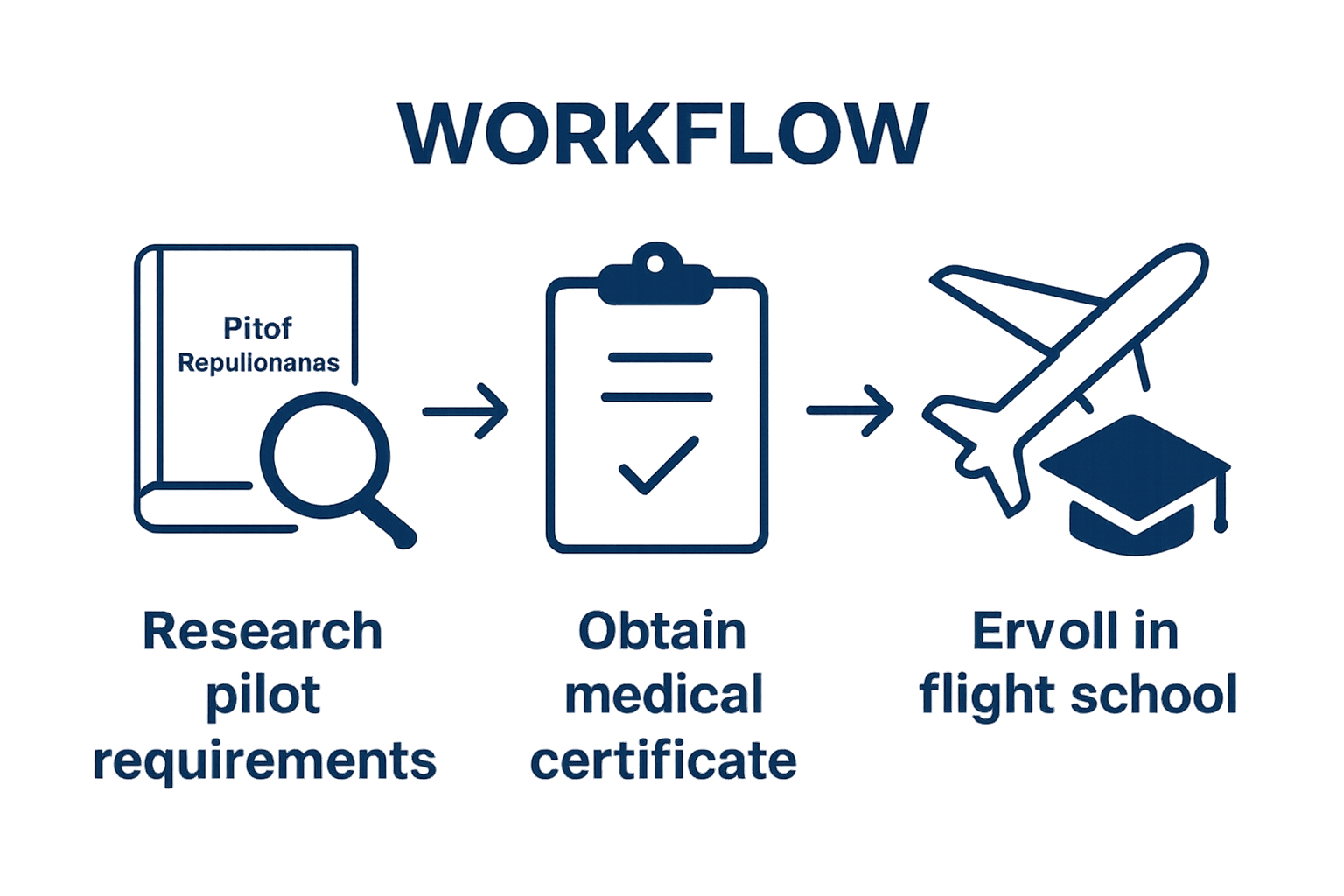
Step 2: Choose the Right Flight School for Your Needs
Selecting the appropriate flight school is a pivotal decision that will shape your entire pilot training journey. Not all flight schools are created equal, and finding the right institution requires careful research, personal assessment, and strategic planning. Explore aviation career pathways to understand how your choice of flight school impacts your long-term professional trajectory.
Begin by evaluating the two primary training routes available: integrated and modular courses. Integrated courses offer a comprehensive, structured programme where you complete all training stages in a continuous sequence.
The following table compares integrated and modular flight training paths, helping you assess which training method best suits your goals and circumstances.
| Training Path | Structure | Flexibility | Duration | Typical Cost | Best Suited For |
|---|---|---|---|---|---|
| Integrated Course | Continuous, structured, all-in-one programme | Low | Shorter (fast-track) | Higher | Those wanting a streamlined, career-focused route |
| Modular Course | Separate modules completed at one’s own pace | High | Variable | Potentially lower | Those needing flexibility or with budget constraints |
Key factors to consider in your selection include:
- School accreditation and reputation
- Training aircraft fleet and maintenance standards
- Instructor experience and qualifications
- Success rates of previous students
- Total programme cost and potential financing options
- Geographic location and training environment
Research goes beyond online brochures. Attend open days, speak with current students, and request detailed information packages from potential schools. Some institutions offer trial lessons or simulator experiences, which can provide invaluable insights into their training methodology and facility quality.
Financial considerations play a significant role in your selection. Compare the total cost of training, including hidden expenses like examination fees, medical certificates, and additional study materials. Some flight schools offer transparent pricing structures and potential scholarship or financing programmes.
Investigate the school’s partnerships with airlines and their graduate employment record. A school with strong industry connections can provide substantial advantages in your future career progression. Look for institutions that offer comprehensive support beyond basic training, such as career guidance and networking opportunities.
Technological infrastructure is another critical evaluation criterion. Modern flight schools should provide advanced training technologies, including high-quality flight simulators, digital learning platforms, and comprehensive theoretical instruction resources.
Ultimately, your chosen flight school should align with your personal learning style, career goals, and financial capabilities. Take time to make an informed decision, as this choice will significantly influence your path to becoming a professional pilot. Conduct thorough research, ask detailed questions, and trust your instincts when selecting the institution that feels right for your aviation journey.
Step 3: Obtain a Medical Certificate from an Aviation Medical Examiner
Obtaining a medical certificate is a critical step in your pilot training journey, serving as a fundamental requirement that ensures your physical and mental fitness to operate aircraft. Aviation authorities mandate specific medical standards that every aspiring pilot must meet before advancing in their training. Learn about helicopter pilot certification nuances to understand how medical requirements can vary across different aviation disciplines.
The medical certification process involves a comprehensive examination conducted by an authorized aviation medical examiner (AME). These specialized healthcare professionals perform detailed assessments that go far beyond standard medical check-ups. You will undergo a thorough evaluation covering multiple health domains, including vision, hearing, cardiovascular health, neurological functioning, and psychological fitness.
Medical certificates are typically categorized into different classes, each with specific requirements:
To help you prepare for the pilot medical certification process, the following table summarises the main medical certificate classes and their typical requirements as described in the guide.
| Certificate Class | Purpose | Typical Applicants | Key Medical Requirements |
|---|---|---|---|
| Class 1 | Commercial airline operations | Airline and commercial pilots | Full physical, ECG, vision, hearing |
| Class 2 | Private flying | Private pilots | Standard physical, vision, hearing |
| Class 3 | Air traffic control | Air traffic controllers | Physical, vision, hearing |
- Class 1 Medical Certificate: Required for commercial and airline transport pilots
- Class 2 Medical Certificate: Suitable for private pilots
- Class 3 Medical Certificate: Designed for air traffic controllers
Prepare for your medical examination by gathering comprehensive personal and family medical history documentation. This includes previous medical records, current medication details, surgical histories, and any chronic health conditions. Transparency is crucial during this process, as withholding information can lead to certificate denial or future complications.
According to European Union Aviation Safety Agency medical guidelines, the examination will typically include:
- Comprehensive physical examination
- Vision and color perception tests
- Audiometry and hearing assessments
- Electrocardiogram (ECG) for cardiovascular screening
- Lung function tests
- Neurological and psychological evaluations
Be prepared for potential additional tests or specialist consultations depending on your individual health profile. Some medical conditions might require further investigation or periodic re-evaluations to maintain your certification.
The medical examination can be intimidating, but approaching it with preparation and honesty will significantly improve your chances of success. Schedule your examination well in advance of your planned training start date, as processing times and potential follow-up assessments can vary.
Successful completion of your medical certificate represents a significant milestone in your pilot training journey. It validates your physical readiness to pursue a career in aviation and demonstrates your commitment to maintaining the highest safety standards in the profession. Once obtained, your medical certificate becomes a crucial document that must be regularly renewed to maintain your flying privileges.
Step 4: Enrol in Ground School and Complete Theoretical Training
Ground school represents the academic foundation of your pilot training, where you will acquire the critical theoretical knowledge essential for safe and professional aircraft operation. Theoretical training is not merely a prerequisite but a comprehensive education that transforms you from an aviation enthusiast to a knowledgeable professional pilot. Check out our comprehensive online ground school tips to maximize your learning potential during this crucial phase.
Your ground school curriculum will cover an extensive range of complex subjects that form the intellectual backbone of aviation. These typically include:
This table provides an overview of the typical ground school subjects you will encounter during your pilot training theoretical phase.
| Subject Area | Description |
|---|---|
| Aerodynamics & Aircraft Systems | Principles of flight and aircraft operations |
| Navigation & Meteorology | Route planning, map reading, and weather analysis |
| Air Law & Regulations | Legal responsibilities, rules of the air |
| Flight Planning & Performance | Calculating flight logistics, weight, and balance |
| Radio Communications | Using aviation radio procedures effectively |
| Human Factors & Crew Resource Management | Understanding limitations and working safely as a team |
- Aerodynamics and aircraft systems
- Navigation and meteorology
- Air law and regulations
- Flight planning and performance calculations
- Radio communications
- Human factors and crew resource management
Modern ground school programmes offer significant flexibility, with many institutions providing online and in-person options. Online learning platforms have revolutionized pilot training, allowing students to study comprehensively while maintaining personal and professional commitments. These digital environments often include interactive modules, practice examinations, and real-time instructor support.
Choosing between integrated and modular training approaches will significantly impact your theoretical education strategy. Integrated courses provide a structured, continuous learning experience where theoretical and practical training are tightly synchronized. Modular approaches offer more individual flexibility, enabling you to complete theoretical components at your own pace.
Successful theoretical training demands disciplined study habits and strategic learning techniques. Develop a consistent study schedule, leverage multiple learning resources, and engage actively with course materials. Practice examinations are particularly crucial, as they not only test your knowledge but also familiarize you with the examination format and time management strategies.
Financial planning is another critical consideration during ground school. Tuition costs, study materials, and examination fees can be substantial. Many flight schools offer comprehensive packages or flexible payment options to support students through this intensive educational phase.
Your theoretical training culminates in a series of examinations that test your comprehensive understanding across multiple aviation domains. Passing these examinations is mandatory for progressing to practical flight training. Approach these assessments with thorough preparation, maintaining a systematic study approach and seeking additional support when encountering challenging topics.
Remember that ground school is more than memorizing facts it is about developing a profound understanding of aviation principles that will underpin your entire flying career. Embrace the learning process, remain curious, and view each study session as a step closer to your dream of becoming a professional pilot.
Step 5: Begin Flight Training with a Certified Instructor
Flight training marks the most exhilarating phase of your pilot journey, transforming theoretical knowledge into practical aviation skills. Your certified flight instructor becomes your primary mentor, guiding you through the complex process of learning to operate an aircraft safely and professionally. Explore our comprehensive online pilot courses to complement your practical training experience.
Your initial flight training will focus on fundamental skills that form the cornerstone of aviation proficiency. These critical initial lessons typically involve understanding aircraft controls, mastering basic manoeuvres, and developing situational awareness. Expect your first sessions to be ground-based, where your instructor will meticulously explain aircraft systems, pre-flight procedures, and safety protocols before you ever touch the controls.
Key initial training elements include:
- Aircraft familiarisation and cockpit orientation
- Understanding instrument panels and control mechanisms
- Basic aircraft handling techniques
- Emergency procedure introductions
- Communication protocols
During early training stages, you will predominantly work with single-engine aircraft designed for pilot instruction. These planes provide a stable learning platform where you can develop core flying competencies without overwhelming complexity. Your instructor will progressively introduce more challenging scenarios, gradually building your confidence and technical skills.
Psychological preparation is as crucial as technical training. Flying demands exceptional mental discipline, situational awareness, and calm decision-making. Your certified instructor will help you develop these essential cognitive skills, teaching you to manage stress, make rapid assessments, and maintain composure under varying flight conditions.
Documentation plays a critical role throughout flight training. You will maintain a detailed logbook recording every flight hour, manoeuvre, and training milestone. These records are not merely administrative requirements but serve as tangible evidence of your developing professional expertise.
Expect your training to be structured around progressive skill acquisition. Initial lessons will involve basic manoeuvres like straight and level flight, turns, climbs, and descents. As you demonstrate proficiency, your instructor will introduce more complex techniques such as stall recovery, navigation exercises, and advanced communication procedures.
Remember that becoming a pilot is a journey of continuous learning. Each flight represents an opportunity to refine your skills, expand your understanding, and inch closer to your aviation dreams. Approach each lesson with humility, curiosity, and unwavering dedication to mastering the art and science of flying.
Step 6: Complete Required Flight Hours and Pass the Checkride
Accumulating the required flight hours represents a pivotal milestone in your pilot training journey, transforming theoretical knowledge into verifiable practical experience. Precise documentation and strategic hour acquisition become your primary focus during this critical phase. Learn essential strategies for logging flight hours to ensure accurate and comprehensive record-keeping throughout your training.
According to European aviation regulations, specific hour requirements vary depending on the type of pilot licence you are pursuing. For a Private Pilot License, you will typically need to demonstrate a minimum of 45 flight hours, which include both dual instruction time and solo flight experience.
Your flight hour compilation will encompass diverse training scenarios:
- Dual instruction with a certified flight instructor
- Solo navigation flights
- Cross-country flight experiences
- Night flying sessions
- Instrument training scenarios
Careful and meticulous logging becomes paramount during this phase. Your flight logbook serves as an official record of your progression, documenting each flight’s specific details including date, aircraft type, flight duration, and particular skills practiced. Every hour represents not just time in the air, but a progressive step towards professional certification.
The checkride represents the culmination of your training, a comprehensive examination that evaluates your theoretical knowledge and practical flying skills. This final assessment involves both a written examination and a practical flight test conducted by an authorized examiner. The examiner will assess your ability to safely operate an aircraft, make sound decisions, and demonstrate proficiency across multiple aviation domains.
Psychological preparation is equally crucial as technical preparation. The checkride can be an intense, high-pressure experience that tests not just your flying skills, but your ability to remain calm and focused under scrutiny. Many successful pilots recommend extensive practice, mock checkrides, and mental preparation techniques to manage test anxiety.
Beyond meeting hour requirements, focus on quality of experience. Each flight should be viewed as an opportunity to refine your skills, develop situational awareness, and build the confidence necessary for professional aviation. Your instructor will provide guidance on which specific skills and scenarios will be evaluated during the checkride, allowing you to target your training effectively.
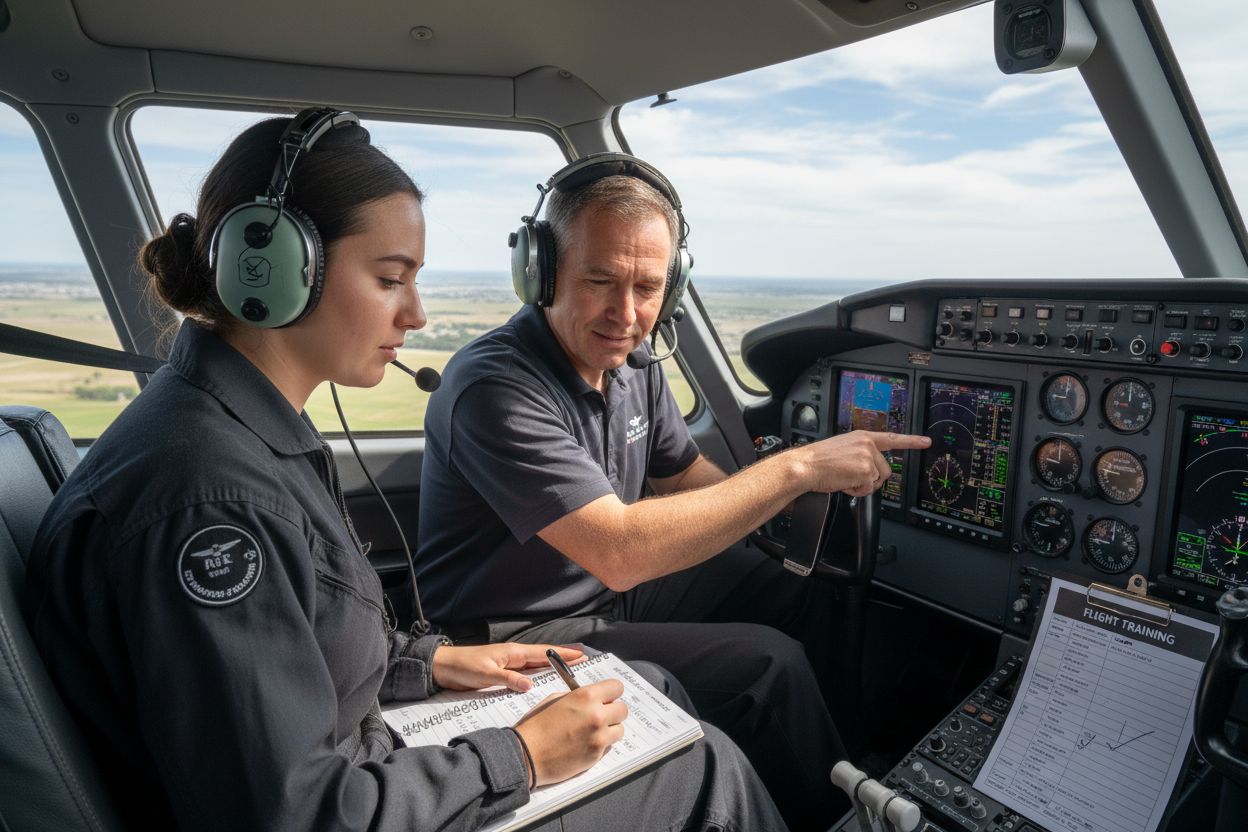
Successful completion of required flight hours and passing the checkride represents more than just a technical achievement. It is a profound personal milestone that transforms you from a student pilot to a certified aviator, ready to embark on the next phase of your aviation career.
Make Your Pilot Ambition a Reality with VictorOne Academy
Feeling overwhelmed by the complex steps to becoming a pilot? From grasping ever-changing EASA regulations to finding quality theoretical training and acing rigorous exams, many aspiring pilots struggle to turn passion into profession. You want guidance that is accurate, accessible and designed for international standards, so you stay on track — and ahead.
Explore our Academy solutions tailored to each stage of your journey.
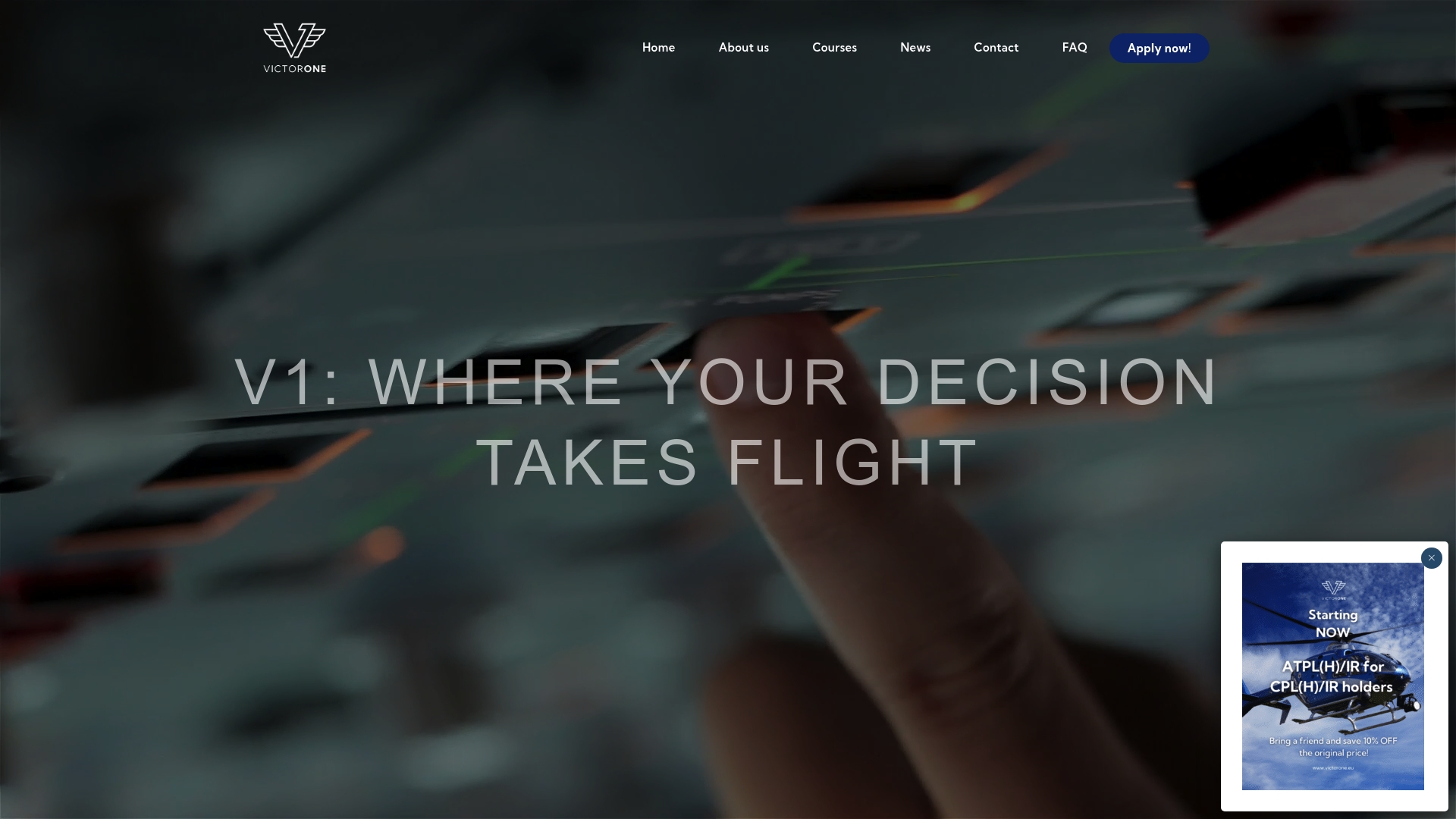
Join VictorOne.eu and experience fully online, EASA-approved pilot theory courses, including ATPL(A) and essential licensing exams. Study from anywhere at your own pace using digital materials, interactive question banks and expert-led consultations. Enrol now at VictorOne.eu to unlock the knowledge, flexibility and global recognition you need to launch your aviation career. Let your training match your ambition — start today.
Frequently Asked Questions
What are the initial requirements to become a pilot?
To become a pilot, you generally need to meet minimum age requirements, complete secondary education, obtain basic medical fitness standards, and demonstrate language proficiency, particularly in English.
How do I choose the right flight school for my pilot training?
When selecting a flight school, consider factors such as accreditation, reputation, training aircraft, instructor qualifications, success rates, costs, geographic location, and the type of training programme (integrated vs. modular).
What does a medical examination for pilot certification involve?
A medical examination for pilot certification involves a comprehensive assessment of your health by an authorised aviation medical examiner, including vision and hearing tests, cardiovascular screenings, and evaluations of neurological and psychological fitness.
What are the key components of ground school training for pilots?
Ground school training includes theoretical knowledge on aerodynamics, navigation, air law, flight planning, weather, and human factors, typically offered through both online and in-person formats.

